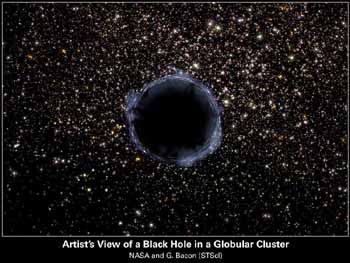Medium weight, in cosmic terms
Direct link to this page: htt://www.hayadan.org.il/newblackhole.html
John Noble Wilford/Abby Blizovsky (see news below)

The "Hubble" space telescope for the first time detected clear evidence of a new category of black holes - astronomers reported last week. The discovery is expected to yield insights into the evolution of black holes and the formation of galaxies in the early universe.
At a press conference at NASA's Washington offices on Tuesday, astronomers described how they discovered two medium-mass black holes. These black holes are much heavier than those created by the collapse of one giant star, but much lighter than the giant holes that weigh about billions of stars, which are fixed at the center of most galaxies.
Astronomers have found the medium-sized black holes at the center of constellations called "globular clusters". In these clusters reside the oldest stars in the universe, and these are relatively static regions. From this, scientists concluded that the black holes were formed around the time when the clusters themselves were formed.
One of the discovered holes has a mass 4,000 times greater than the mass of the Sun, and is located in the center of the globular star cluster, M15, 32 light years from Earth; It has a mass 20 thousand times greater than that of the Sun, and it was located in the giant globular cluster, G1, which is 2.2 million light years from Earth.
One of the most fascinating aspects of the new discovery is the fact that the masses of the two intermediate black holes are proportional in size to the masses of the clusters within which they reside. It is known from previous studies that the giant black holes, which reside in the whites of galaxies, make up about half the percent of the masses of the galaxies that host them. It turns out that this is exactly the mass ratio between medium black holes and the host star clusters. According to researchers, this may be the "missing link" in the study of the early universe. "When you notice a relationship in astronomy, there is almost always a reason for it," said Dr. Carl Gebhadt, an astronomer at the University of Texas at Austin.
New York Times

Star clusters. G1 "missing link" in the study of galaxies
Hubble discovered black holes in unexpected places - in small globular star clusters
Medium-sized black holes exist. This is according to recent studies by the Hubble Space Telescope, but the scientists had to look in unexpected places to find them. The black holes not found in previous searches provide an important link and shed light on how black holes grow. Moreover, black holes were actually found among bright neighbors - globular star clusters, such as those surrounding the Milky Way and other large galaxies.
The new findings promise a better understanding of how galaxies and globular clusters formed billions of years ago. Globular clusters contain the oldest stars in the universe. If there are black holes there, then it is a sign that the black holes were there when they were formed, unlike in the large galaxies where the black hole in the center was formed as a result of the explosion of massive stars.
Roland van der Marl of the Space Telescope Science Institute in Baltimore says this means black holes are more common than previously thought.
Intermediate-sized black holes are a link between supermassive black holes and those that have the mass of one star. This connection is important because it may hold the connection between the question of how supermassive black holes are formed in galaxies. The size of the black holes is due to their stellar environment (the number of stars they swallow).
Supermassive black holes at the center of galaxies make up about half a percent of the galaxy's mass. Black holes now found in star clusters ten thousand times smaller than the mass of a galaxy also follow the same trend. There appears to be an as yet undiscovered process linking the mass of the black hole to its galactic surroundings. Nature provides us with a thick clue about the systems formed by the black stars.
News by Alex Doron, Maariv, 29/9/2002
The "Hubble" space telescope (which will be replaced in 2010 by a newer one, named "Web") discovered in a giant globular star cluster, the first medium-sized "black hole" - what astronomers call the "missing link" in the puzzle that allows explaining how the first galaxies in the primordial universe were formed. The globular cluster contains the oldest stars in the universe, and if there are "black holes" in it now, there were probably as many of them in their formation as well.
The discovery shows that the more massive and larger the star cluster is, the larger and "heavier" central black hole will be found in it, and the same ratio exists as a mirror image, in galaxies that contain super-large black holes. The observation also shows that all galaxies probably started from a relatively small "basic nucleus" that grew over time - and not, as previously thought, that they all formed at once, from clouds of cosmic dust and gas.
Dr. Roland van der Marl from the Space Telescope Research Institute in Baltimore and his colleague Michael Rich from the University of California, Los Angeles, reported that "Hubble" examined what is happening in the star cluster marked M15, about 32 thousand light-years away from us in the constellation Pegasus.
They measured the speed of motion of the stars near the core of the cluster. It turned out that the "medium" sized black hole is 4000 times bigger and heavier than our sun. Before that, the same team discovered a black hole 20 thousand times bigger than the Sun in the G1 cluster in the Andromeda galaxy, 2.2 million light years away. The two black holes make up half a percent of the mass of the cluster that hosts them.
https://www.hayadan.org.il/BuildaGate4/general2/data_card.php?Cat=~~~322959293~~~202&SiteName=hayadan
